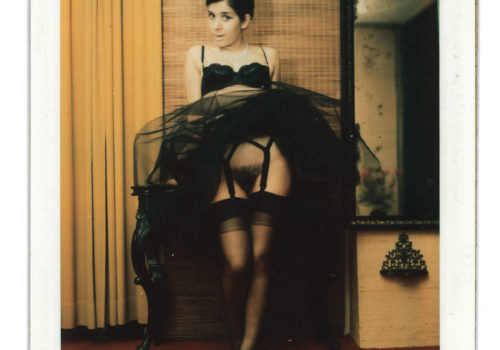Carlo Mollino is known as an architect and furniture designer, he was also a writer, photographer, race-car driver and downhill skier.
He appears to be an universal and multitalented artist, living several different lives in order to meet all the requirements of his diverse ambitions, interests and obsessions.
As an architect, he designed interiors of villas, a riding club, Turin’s Teatro Regio, as well as ski lift stations and Alpine chalets. The style in which he designed interiors and furniture could be named “streamlined Surrealism”, for which design collectors today are willing to pay the highest prices.
His private life was intense, too. His most personal obsession was discovered after his death in the form of Polaroid exposures of girlfriends, prostitutes and other women seduced in his Turin residence. Beauties from Turin’s nightlife posed for him. In 1962, Mollino began employing Polaroid film for these shoots, making some 1,300 exposures before his death.
The book Carlo Mollino: Un Messaggio dalla Camera Oscura reveals the man through his images of erotic portraiture. The scenes were carefully prepared, he left nothing to chance. He carefully arranged the settings on a mostly minimalist stage, the models would dress and partially undress in costumes, accessories and wigs that Mollino had acquired on trips to France or Southeast Asia, and pose before backdrops of drapery, screens and sculptural furniture. The models appear more statuesque than pornographic and they are on the same wavelength with the opulent interiors and opulent furnishings of Mollino’s private homes in Turin, the Villa Zaira is a crucial part of the compositions.
The austere composition and the aesthetic posing of the female body call up clear parallels between object and figure, nature and design, human and architectural form.
Un Messaggio dalla Camera Oscura (Message from the darkroom), was first published in italy in 1949 by Chiantore publishers. It was like an history of photography, a lucid essay on the artistic nature of photography, enriched with his own female portraits in line with classical studio photography, starting in 1960, he turned to the most modern photographic medium at the time, the Polaroid.
The book is a light on his ambivalence, on the diversity of his work and on the person Carlo Mollino. In the Polaroid photographs and in the mysteries of his life, the artistic intentions of Carlo Mollino come into focus. His work and life express an harmonious Combination of science and art.
This work manifest his mental and artistic point of view that could be expressed in Carlo Mollino’s maxim: “Everything is allowed as long as it is fantastic.”
Emiliana Tedesco
Carlo Mollino: Un Messaggio dalla Camera Oscura
Edited by Gerald A. Matt. Text by Napoleone Ferrari, Lucas Gehrmann, Gerald A. Matt.
MODERNE KUNST NüRNBERG
220 pages
Euro 30,–
German and English edition
















